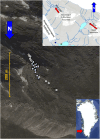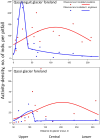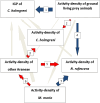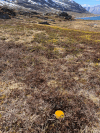Arthropod Food Webs in the Foreland of a Retreating Greenland Glacier: Integrating Molecular Gut Content Analysis With Structural Equation Modelling
- PMID: 39697976
- PMCID: PMC11652110
- DOI: 10.1002/ece3.70687
Arthropod Food Webs in the Foreland of a Retreating Greenland Glacier: Integrating Molecular Gut Content Analysis With Structural Equation Modelling
Abstract
The Arctic has warmed nearly four times faster than the global average since 1979, resulting in rapid glacier retreat and exposing new glacier forelands. These forelands offer unique experimental settings to explore how global warming impacts ecosystems, particularly for highly climate-sensitive arthropods. Understanding these impacts can help anticipate future biodiversity and ecosystem changes under ongoing warming scenarios. In this study, we integrate data on arthropod diversity from DNA gut content analysis-offering insight into predator diets-with quantitative measures of arthropod activity-density at a Greenland glacier foreland using Structural Equation Modelling (SEM). Our SEM analysis reveals both bottom-up and top-down controlled food chains. Bottom-up control, linked to sit-and-wait predator behavior, was prominent for spider and harvestman populations, while top-down control, associated with active search behavior, was key for ground beetle populations. Bottom-up controlled dynamics predominated during the early stages of vegetation succession, while top-down mechanisms dominated in later successional stages further from the glacier, driven largely by increasing temperatures. In advanced successional stages, top-down cascades intensify intraguild predation (IGP) among arthropod predators. This is especially evident in the linyphiid spider Collinsia holmgreni, whose diet included other linyphiid and lycosid spiders, reflecting high IGP. The IGP ratio in C. holmgreni negatively correlated with the activity-density of ground-dwelling prey, likely contributing to the local decline and possible extinction of this cold-adapted species in warmer, late-succession habitats where lycosid spiders dominate. These findings suggest that sustained warming and associated shifts in food web dynamics could lead to the loss of cold-adapted species, while brief warm events may temporarily impact populations without lasting extinction effects.
Keywords: Aclastus borealis; Isotoma anglicana; Mitopus morio; NDVI; Nebria rufescens; antipredatory behavior; deglaciation; detritivores; extra‐guild prey; pioneer vegetation.
© 2024 The Author(s). Ecology and Evolution published by John Wiley & Sons Ltd.
Conflict of interest statement
The authors declare no conflicts of interest.
Figures

 , 277–291 MASL, in the shadow of the mountain with one wet pitfall trap at each patch; central transect patches
, 277–291 MASL, in the shadow of the mountain with one wet pitfall trap at each patch; central transect patches , 242–277 MASL, with partly shadow during a midsummer day with a wet pitfall (blue dot) and a dry pitfall trap (black dot) at each patch; lower transect patches
, 242–277 MASL, with partly shadow during a midsummer day with a wet pitfall (blue dot) and a dry pitfall trap (black dot) at each patch; lower transect patches , 206–242 MASL, without shadow during a midsummer day, with one wet pitfall trap at each patch. Right hand side red arrows show the position of the whole Kobbefjord area (lower right) and the position of the 2014 study transect within the Kobbefjord area east of the Little Qassi Mountain as well as the crowberry
, 206–242 MASL, without shadow during a midsummer day, with one wet pitfall trap at each patch. Right hand side red arrows show the position of the whole Kobbefjord area (lower right) and the position of the 2014 study transect within the Kobbefjord area east of the Little Qassi Mountain as well as the crowberry  and gray willow
and gray willow  plots in the Kobbefjord valley.
plots in the Kobbefjord valley.





 = frequency consistent with the null model (the observed predation frequency corresponded to the expected one based on prey activity‐density and gut content results);
= frequency consistent with the null model (the observed predation frequency corresponded to the expected one based on prey activity‐density and gut content results);  = frequency of predation was higher than expected in the null model;
= frequency of predation was higher than expected in the null model;  = frequency of predation was lower than expected according to the null model.
= frequency of predation was lower than expected according to the null model.












Similar articles
-
Resolving the predator first paradox: Arthropod predator food webs in pioneer sites of glacier forelands.Mol Ecol. 2019 Jan;28(2):336-347. doi: 10.1111/mec.14839. Epub 2018 Sep 7. Mol Ecol. 2019. PMID: 30118154 Free PMC article.
-
Intraguild predation in pioneer predator communities of alpine glacier forelands.Mol Ecol. 2014 Aug;23(15):3744-54. doi: 10.1111/mec.12649. Epub 2014 Feb 3. Mol Ecol. 2014. PMID: 24383765 Free PMC article.
-
Ecosystem Birth Near Melting Glaciers: A Review on the Pioneer Role of Ground-Dwelling Arthropods.Insects. 2020 Sep 19;11(9):644. doi: 10.3390/insects11090644. Insects. 2020. PMID: 32961739 Free PMC article. Review.
-
Assembly patterns of soil-dwelling lichens after glacier retreat in the European Alps.J Biogeogr. 2017 Jun;44(6):1393-1404. doi: 10.1111/jbi.12970. Epub 2017 Feb 23. J Biogeogr. 2017. PMID: 28701808 Free PMC article.
-
Knowing your enemies: Integrating molecular and ecological methods to assess the impact of arthropod predators on crop pests.Insect Sci. 2015 Feb;22(1):6-19. doi: 10.1111/1744-7917.12157. Epub 2014 Nov 13. Insect Sci. 2015. PMID: 25081301 Review.
References
-
- Abrams, P. A. 2010. “Implications of Flexible Foraging for Interspecific Interactions: Lessons From Simple Models.” Functional Ecology 24: 7–17.
-
- Agustí, N. , Shayler S. P., Harwood J. D., Vaughan I. P., Sunderland K. D., and Symondson W. O. C.. 2003. “Collembola as Alternative Prey Sustaining Spiders in Arable Ecosystems: Prey Detection Within Predators Using Molecular Markers.” Molecular Ecology 12: 3467–3475. - PubMed
-
- Ahmed, M. , Else B., Eklundh L., Ardö J., and Seaquist J.. 2017. “Dynamic Response of NDVI to Soil Moisture Variations During Different Hydrological Regimes in the Sahel Region.” International Journal of Remote Sensing 38: 5408–5429.
-
- Allen, D. C. , McCluney K. E., Elser S. R., and Sabo J. L.. 2014. “Water as a Trophic Currency in Dryland Food Webs.” Frontiers in Ecology and the Environment 12: 156–160.
-
- Arbuckle, J. L. 2022. “IBM® SPSS® Amos™ 29 User's Guide.”
Associated data
LinkOut - more resources
Full Text Sources

